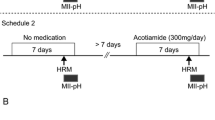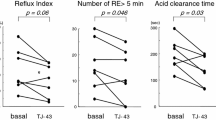Abstract
Rikkunshito (TJ-43), a herbal medicine consisting of eight herbs, is used to treat chronic dyspepsia. Studies have shown that TJ-43 improves human gastric emptying. This study investigated the effects of TJ-43 on the clinical symptoms and esophageal acid exposure in children with symptomatic gastroesophageal reflux (GER). Eight children, aged from 2 months to 15 years (median age 4 years), were studied. Six of them had neurological impairment. TJ-43 (0.3 g/kg/day) was given orally or via nasogastric tubes in three divided doses before meals for 7 days. Their symptoms were frequent emesis in four, nausea in two, and hematemesis and stridor in one each. Twenty-four-hour esophageal pH monitoring was conducted using multichannel pH electrodes located at the distal esophagus (P1) and 10 cm proximal to P1 (P2). The clinical symptoms and esophageal pH were compared before and after TJ-43 therapy for 1 week. The frequency of emesis decreased in three patients. Other symptoms, including nausea, hematemesis, and stridor, were relieved in the remaining patients. Measured at the distal pH electrode, the percentage time of esophageal pH < 4.0 and the mean duration of reflux decreased significantly (P < 0.05). However, the number of acid reflux per hour did not change significantly, and no pH parameters measured at the proximal electrode differed significantly. The short-term administration of TJ-43 relieved symptoms and reduced the distal esophageal acid exposure through improved esophageal acid clearance.

Similar content being viewed by others

References
Kawahara H, Dent J, Davidson G (1997) Mechanisms responsible for gastroesophageal reflux in children. Gastroenterology 113:399–408
Tovar JA, Luis AL, Encinas JL et al (2007) Pediatric surgeons and gastroesophageal reflux. J Pediatr Surg 42:277–283
Di Lorenzo C, Orenstein S (2002) Fundoplication: friend or foe? J Pediatr Gastroenterol Nutr 34:117–124
Hassall E (2005) Outcomes of fundoplication: causes for concern, newer options. Arch Dis Child 90:1047–1052
Spechler SJ, Lee E, Ahnen D et al (2001) Long-term outcome of medical and surgical therapies for gastroesophageal reflux disease: follow-up of a randomized controlled trial. JAMA 285:2331–2338
Lobe TE (2007) The current role of laparoscopic surgery for gastroesophageal reflux disease in infants and children. Surg Endosc 21:167–174
Omari TI, Benninga MA, Sansom L et al (2006) Effect of baclofen on esophagogastric motility and gastroesophageal reflux in children with gastroesophageal reflux disease: a randomized controlled trial. J Pediatr 149:468–474
Kawai M, Kawahara H, Hirayama S et al (2004) Effect of baclofen on emesis and 24-hour esophageal pH in neurologically impaired children with gastroesophageal reflux disease. J Pediatr Gastroenterol Nutr 38:317–323
Tatsuta M, Iishi H (1993) Effect of treatment with Liu-Jun-Zi-Tang (TJ-43) on gastric emptying and gastrointestinal symptoms in dyspeptic patients. Aliment Pharmacol Ther 7:459–462
Yagi M, Homma S, Kubota M et al (2004) The herbal medicine Rikkunshi-to stimulates and coordinates the gastric myoelectric activity in post-operative dyspeptic children after gastrointestinal surgery. Pediatr Surg Int 19:760–765
Cucchiara S, Staiano A, Boccieri A et al (1990) Effects of cisapride on parameters of esophageal pH test in infants with gastro-oesophageal reflux disease. Gut 31:21–25
Dubin A, Kikkert M, Mirmiran M et al (2001) Cisapride associated with QTc prolongation in very low birth weight preterm infants. Pediatrics 107:1313–1316
Hayakawa T, Arakawa T, Kase Y et al (1999) Liu-Jun-Zi-Tang, a Kampo medicine, promotes adaptive relaxation in isolated guinea pig stomachs. Drugs Exp Clin Res 25:211–218
Kido T, Nakai Y, Kase Y et al (2005) Effects of Rikkunshi-to, a traditional Japanese medicine, on the delay of gastric emptying induced by N(G)-nitro-l-arginine. J Pharmacol Sci 98:161–167
Scott RB, Ferreira C, Smith L et al (1997) Cisapride in pediatric gastroesophageal reflux. J Pediatr Gastroenterol Nutr 25:499–506
Paterson WG, Wang H, Beck IT (1997) The effect of cisapride in patients with reflux esophagitis: an ambulatory esophageal manometry/pH-metry study. Am J Gastroenterol 92:226–230
Carmagnola S, Fraquelli M, Cantu P et al (2006) Relationship between acceleration of gastric emptying and oesophageal acid exposure in patients with endoscopy-negative gastro-oesophageal reflux disease Scand. J Gastroenterol 41:767–772
Kawahara H, Imura K, Yagi M et al (1998) Mechanisms underlying the anti-reflux effect of Nissen fundoplication in children. J Pediatr Surg 33:1618–1622
Sifrim D, Holloway R, Silny J et al (2001) Composition of the postprandial refluxate in patients with gastroesophageal reflux disease. Am J Gastroenterol 96:647–655
Acknowledgment
The authors would like to thank Professor Minoru Yagi (Kurume University School of Medicine, Fukuoka, Japan) for intellectual comments.
Author information
Authors and Affiliations
Corresponding author
Rights and permissions
About this article
Cite this article
Kawahara, H., Kubota, A., Hasegawa, T. et al. Effects of rikkunshito on the clinical symptoms and esophageal acid exposure in children with symptomatic gastroesophageal reflux. Pediatr Surg Int 23, 1001–1005 (2007). https://doi.org/10.1007/s00383-007-1986-7
Published:
Issue Date:
DOI: https://doi.org/10.1007/s00383-007-1986-7



